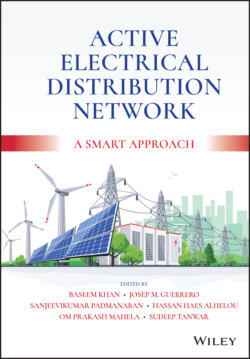Читать книгу Active Electrical Distribution Network - Группа авторов - Страница 51
2.7 Conclusion
ОглавлениеThe basic objective behind this chapter is to discuss a theft-handling mechanism for protecting various power equipment/appliances fitted in agricultural feeders during off-feed hours. The discussed method is based on network reconfiguration in which the normal topological structure of the distribution feeder is changed to a new objective-based structure through closing and opening of the sectionalizing and ties switches. If the agricultural feeder is to be included as the part of the feeder reconfiguration, electricity will be made available during off-feed hours, and hence the thieves will not take any risk. The main tasks involved with the discussed methodology are as follows:
To develop a method to decide the locations of different sectionalizing and tie switches in such a way that the inclusion of some of the section of the agricultural feeder in network reconfiguration will not energize the connected pumps.
To develop a method for the selection of tapping points for the agricultural pumps in such a way that the pumps do not draw power during off-feed hours.
To deduce a best suitable method for network reconfiguration based on the contemporary situation and as per the demand of the Feeder Segregation Plan.
To draw up a plan for distribution system automation (DSA) to manage the network reconfiguration.
To determine the optimal switching frequency for network reconfiguration while considering all its dynamics and impacts.
To validate the above proposed methodologies using high-end tools like ETAP/MATLAB.
The potential threat in the theft of line conductors, transformers, and other electrical elements while segregating the agriculture feeder can be reduced through the use of the discussed scheme. Apart from its basic objective, the inclusion of network reconfiguration will also help in reducing technical losses, improving voltage profile, minimizing outages, reducing device failures, minimizing overloading, smoothing peak demand, and increasing the network reliability. It will further contribute towards the national target of achieving AT&C loss minimization. The outcomes from the discussed methodology will give thrust to the implementation of the Feeder Segregation Plan (FSP) across different Indian states. It will enhance the confidence of the various Indian utilities and provide motivation in implementing the FSP.
As the network reconfiguration has been proposed to be implemented through distribution system automation in the discussed work, this methodology can be initiated as a demand-side management (DSM) program. The nature of the discussed scheme is such that the utilities can implement the plan without depending upon consumer mind sets to control their consumption. The discussed scheme will also help toward improved management of environmental resources through husbanding ground water.
